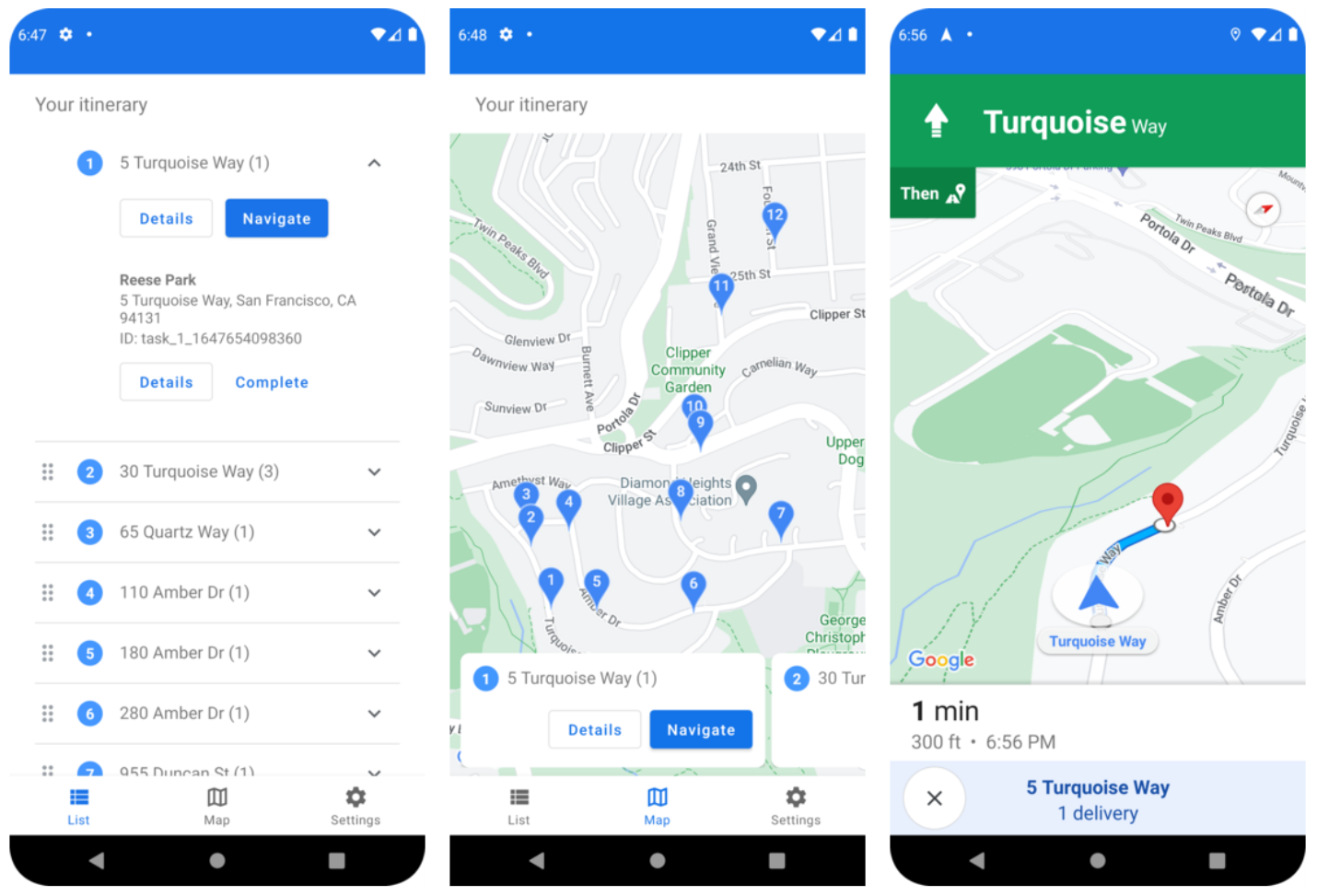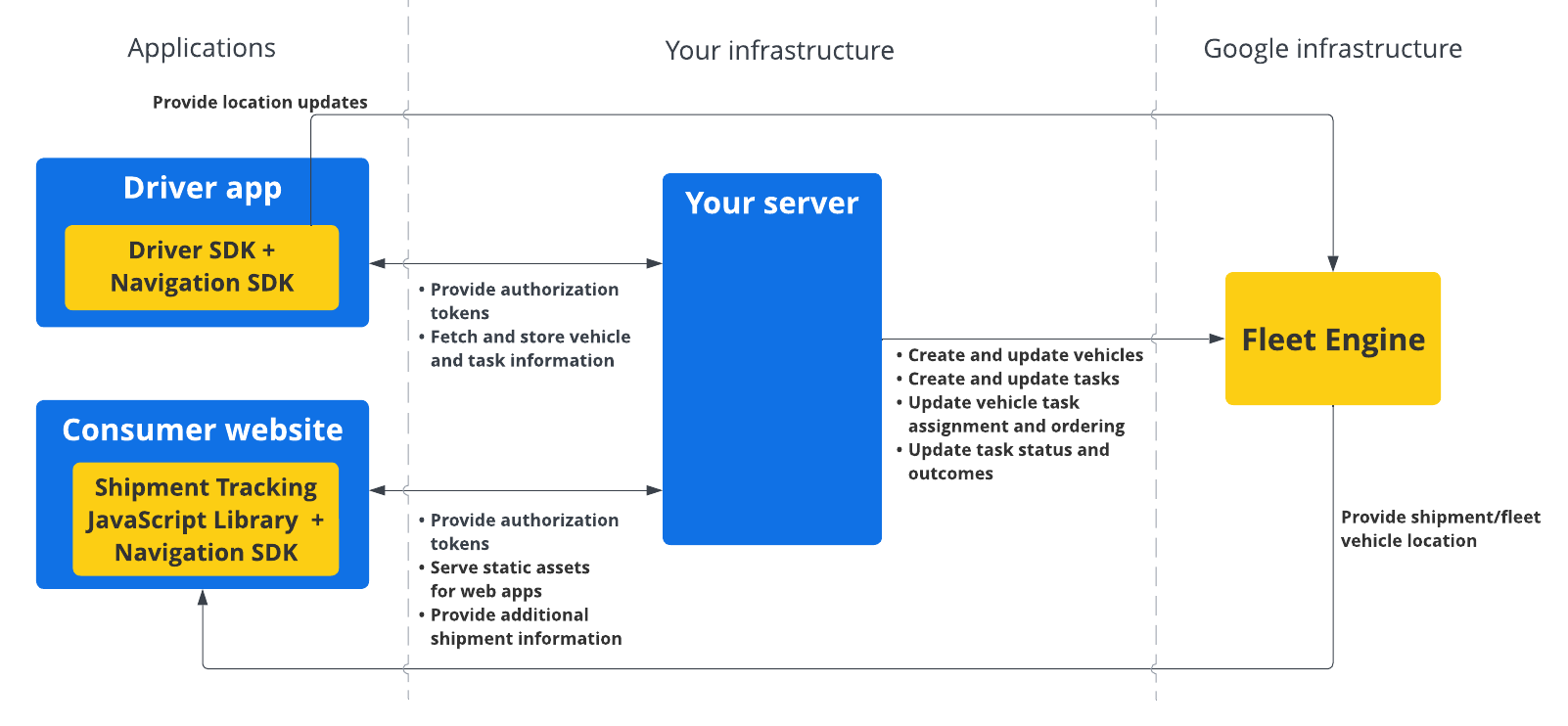
Pakiet Driver SDK to zestaw narzędzi do tworzenia aplikacji mobilnych i podstawowy komponent Fleet Engine. Dzięki temu pakietowi SDK aplikacja dla kierowców może zarządzać przydzielonymi zadaniami oraz umożliwiać kierowcom korzystanie z nawigacji i wyznaczania tras.
Zanim zaczniesz
W tym przewodniku przyjęto założenie, że czytelnik zapoznał się z tymi materiałami:
- Podstawowe informacje o Fleet Engine
- Model danych dla pojazdów.
- Model danych dla zaplanowanych zadań
- Jak skonfigurować Fleet Engine
- Jak tworzyć i używać pojazdów w Fleet Engine
Czym jest pakiet Driver SDK do zaplanowanych zadań?
Pakiet Driver SDK przekazuje do Fleet Engine informacje o lokalizacji pojazdu i aktualizacje zadań, dzięki czemu Fleet Engine może zarządzać pojazdami dostawczymi oraz przypisanymi do nich przystankami i zadaniami. Pakiet SDK korzysta z nasłuchiwania zdarzeń, aby wysyłać aktualizacje lokalizacji oraz współrzędne geograficzne (długość i szerokość) wraz z bieżącym segmentem trasy i miejscem docelowym z pakietu Navigation SDK do Fleet Engine, gdy kierowca zaczyna prowadzić pojazd.
Dlaczego warto używać pakietu Driver SDK do zadań zaplanowanych?
Driver SDK umożliwia łatwiejszą integrację z Fleet Engine w celu aktualizacji tras kierowcy. Dzięki temu pakietowi SDK kierowca może zarządzać przydzielonymi zadaniami i korzystać z nawigacji w jednej aplikacji, tak jak w przypadku konsumenckiej wersji Map Google, ale bez konieczności przełączania się na inną aplikację.
Możliwości pakietu Driver SDK w przypadku zaplanowanych zadań
Użyj pakietu Driver SDK do zaplanowanych zadań, aby przekazywać do Fleet Engine te informacje:
- bieżącą lokalizację pojazdu dostawczego na mapie;
- Współrzędne geograficzne przystanku.
- Pozostała odległość do przystanku.
- Szacowany czas dotarcia na przystanek.
- Trasa, którą ma pokonać pojazd, zgodnie z informacjami podanymi przez pakiet Navigation SDK.
Jak działa pakiet Driver SDK w przypadku zaplanowanych zadań
Pakiet Driver SDK korzysta z pakietu Navigation SDK w zakresie informacji o trasie i miejscu docelowym. W połączeniu z informacjami z pakietu Navigation SDK pakiet Driver SDK integruje się z aplikacją kierowcy i przesyła do Fleet Engine strumień aktualizacji lokalizacji, współrzędnych geograficznych, pozostałej odległości i szacowanego czasu przyjazdu. Wszystkie inne aktualizacje danych o pojazdach muszą być wysyłane do backendu klienta, który przekazuje dane do Fleet Engine.

Jak korzystać z pakietu Driver SDK w przypadku zaplanowanych zadań
Wybierz platformę, aby dowiedzieć się, jak zacząć korzystać z pakietu Driver SDK.
Android
| 1 | Pobieranie pakietu Driver SDK na Androida | Więcej informacji znajdziesz w artykule Pobieranie pakietu Driver SDK. |
| 2 | Konfigurowanie projektu w konsoli Google Cloud | Więcej informacji znajdziesz w artykule Konfigurowanie projektu w konsoli Google Cloud. |
| 3 | Deklarowanie zależności | Więcej informacji znajdziesz w sekcji Deklarowanie zależności. |
| 4 | Tworzenie tokenów uwierzytelniania | Więcej informacji znajdziesz w artykule Tworzenie tokenów uwierzytelniających. |
| 5 | Zainicjuj pakiet Driver SDK | Więcej informacji znajdziesz w artykule Inicjowanie pakietu Driver SDK. |
| 6 | Przygotuj pojazd | Więcej informacji znajdziesz w artykule Przygotowywanie pojazdu. |
iOS
| 1 | Pobieranie pakietu Driver SDK na iOS | Więcej informacji znajdziesz w artykule Pobieranie pakietu Driver SDK. |
| 2 | Konfigurowanie projektu w konsoli Google Cloud | Więcej informacji znajdziesz w artykule Konfigurowanie projektu w konsoli Google Cloud. |
| 3 | Tworzenie tokenów uwierzytelniania | Więcej informacji znajdziesz w artykule Tworzenie tokenów uwierzytelniających. |
| 4 | Zainicjuj pakiet Driver SDK | Więcej informacji znajdziesz w artykule Inicjowanie pakietu Driver SDK. |
| 5 | Przygotuj pojazd | Więcej informacji znajdziesz w artykule Przygotowywanie pojazdu. |
Co dalej?
Zobacz dokumentację platformy, na której chcesz zainstalować Driver SDK:

